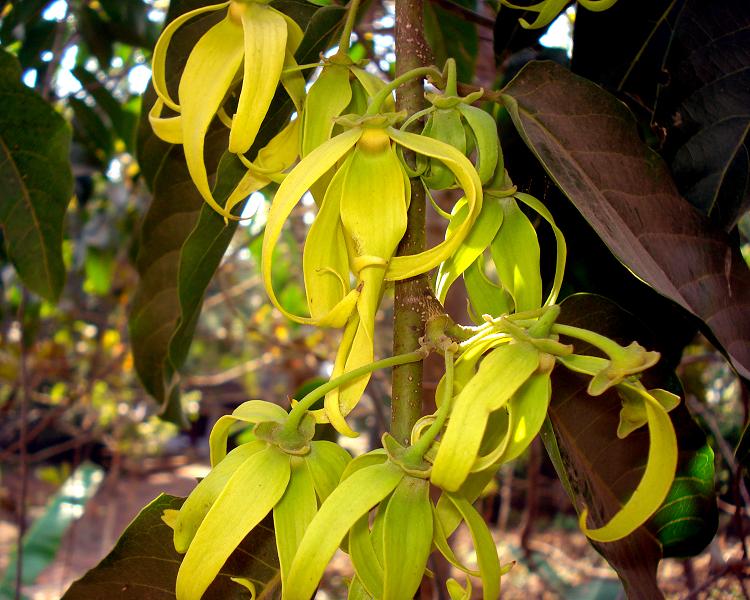학명 : Cananga odorata (Lamarck) J. D. Hooker & Thomson
분류 : 포포나무과(Annonaceae)
중국어명 : 依兰
Common Names : ylang-ylang
사진 : 2023.02.05 부천 수피아식물원






아래 : 2023.02.21 부천수피아식물원




아래 : 2023.03.09 부천수피아식물원








FOC
Cananga odorata (Lamarck) J. D. Hooker & Thomson, Fl. Ind. 1: 130. 1855.
依兰 yi lan
Trees or shrubs. Bark pale gray. Branchlets dark colored, striate with age, minutely pubescent when young, glabrescent. Petiole 1-2 cm, narrowly grooved; leaf blade in 2 ranks, ovate, oblong, or broadly elliptic, 9-23 × 4-14 cm, membranous to thinly papery, often drying black, glabrous when mature except for mostly whitish pubescence along midvein and secondary veins, secondary veins 7-15 on each side of midvein, base rounded, obtuse, or truncate and often inequilateral, apex acute to acuminate. Inflorescences axillary or on short woody branches, racemose or cymose, 1- or several flowered; peduncle 2-5 mm; bracts minute, deciduous. Flowers pendulous. Pedicel 1-5 cm, pubescent, bracteolate. Sepals ovate, ca. 0.7 mm, pubescent, connate at base, apex acute and reflexed. Petals green, turning yellow and inside basally with a purplish brown blotch, linear to linear-lanceolate, 5-8 × 0.5-1.8 cm, tomentose and with several veins minutely pubescent, basal claw small. Stamens oblong-oblanceolate, 0.7-1 mm; connectives apically acute, pubescent. Carpels 10-12, ca. 4 mm, puberulent when young, glabrescent; stigmas clavate, lamellate, fused, with a U-shaped groove on inner side running down to base of ovary to form a convex pileate disk. Monocarp stipes 1.2-1.8 cm; monocarps nearly black, ovoid, globose, or oblong, 1.5-2.3 × ca. 1 cm, pulpy, glabrous. Seeds 2-12 per monocarp, pale brown, in 2 series, surface pitted. Fl. Apr-Aug, fr. Oct-Mar.
Cultivated. Fujian, Guangdong, Guangxi, Hainan, Sichuan, Taiwan, Yunnan [native to NE Australia, India, Indonesia, Laos, Malaysia, Myanmar, Philippines, and Thailand].
The flowers of Cananga odorata are the source of an essential oil used in perfumery, soaps, and cosmetics. The flowers are also laid between cloth to impart an agreeable scent.
종하 분류
1. Tree 6-33 m tall. ................... var. odorata
1. Shrubs 1-2 m tall ................. var. fruticosa

Cananga odorata in Flora of China @ efloras.org
wikipedia 설명
Cananga odorata, known as ylang-ylang (/ˈiːlæŋ ˈiːlæŋ/ EE-lang-EE-lang) or cananga tree, is a tropical tree that is native to the Philippines, Malaysia, Indonesia, New Guinea, the Solomon Islands, and Queensland, Australia. It is also native to parts of Cambodia, Thailand and Vietnam.[1] It is valued for the essential oils extracted from its flowers (also called "ylang-ylang"), which has a strong floral fragrance. Ylang-ylang is one of the most extensively used natural materials in the perfume industry, earning it the name "Queen of Perfumes".[2][3][4]
The ylang-ylang vine (Artabotrys odoratissimus)[5] and climbing ylang-ylang (Artabotrys hexapetalus)[6] are woody, evergreen climbing plants in the same family. Artabotrys odoratissimus is also a source of perfume.[5]
Etymology and nomenclature
The name ylang-ylang is the Spanish spelling of the Tagalog term for the tree, ilang-ilang - a reduplicative form of the word ilang, meaning "wilderness", alluding to the tree's natural habitat.[7] A common mistranslation is "flower of flowers".[5]
The tree is also called the fragrant cananga, Macassar-oil plant, or perfume tree.[8][9] It is called kenanga in Malay, from Proto-Malayo-Polynesian *kanaŋa.[10] Its traditional Polynesian names include Mataʻoi (Cook Islands), Mohokoi (Tonga), Mosoʻoi (Samoa), Motoʻoi (Hawaii), and Mokosoi, Mokasoi or Mokohoi (Fiji).[11]
Description
Cananga odorata is a fast-growing tree of the custard apple family Annonaceae. Its growth exceeds 5 m (16 ft) per year, and it attains an average height of 12 m (39 ft) in an ideal climate.[12] The compound evergreen leaves are pinnate, smooth and glossy, and 13–21 cm (5–8.5 in) long. Leaflets are oval, pointed and with wavy margins. The flower is drooping, long-stalked, with six narrow, greenish-yellow (rarely pink) petals, rather like a sea star in appearance, and yields a highly fragrant essential oil. Its pollen is shed as permanent tetrads.[13]
Distribution and habitat
The plant is native to the Malesian ecoregion, from parts of Mainland Southeast Asia (Thailand and Vietnam), to Maritime Southeast Asia (the Philippines, Malaysia, Indonesia), Papua New Guinea, the Solomon Islands, and to Queensland, Australia. It has been introduced to other tropical regions in the Pacific Islands, South Asia, Africa, and the Americas.[1] It is commonly grown in Madagascar,[14] Polynesia, Melanesia, Micronesia, and the Comoros Islands.[15] It grows in full or partial sun, and prefers the acidic soils of its native rainforest habitat. Ylang-ylang has been cultivated in temperate climates under conservatory conditions.
In Madagascar, it is grown in plantations with Hewittia malabarica (L.) Suresh as a groundcover plant.[14]

꽃은 불가사리 모양이다
